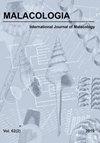温泉中的冷蜗牛:来自巴塔哥尼亚和青藏高原的观测
IF 1
4区 生物学
Q4 ZOOLOGY
引用次数: 6
摘要
巴塔哥尼亚和青藏高原都拥有各种低温淡水资源。肺型淡水腹足类动物在这些水体中广泛分布。然而,这两个地区也拥有许多地热温泉。这些泉水可能是更新世淡水物种的避难所。在本研究中,研究了两个温泉系统,一个在巴塔哥尼亚,一个在青藏高原。在巴塔哥尼亚发现了Chilina patagonica(在巴塔哥尼亚)、auricularia(在青藏高原)和Gyraulus sp.(在青藏高原)的个体。这些分类群通常生活在较低的水温下。在巴塔哥尼亚温泉系统中,腹足类动物从温水到冷水不断出现。线粒体DNA序列分析揭示了青藏高原温泉腹足类动物与冷水种群的亲缘关系。因此,驯化而非适应可能是主要的热调节过程。鉴于这些发现,温泉可能是这些淡水腹足动物的冰川避难所。本文章由计算机程序翻译,如有差异,请以英文原文为准。
Cold Snails in Hot Springs: Observations from Patagonia and the Tibetan Plateau
ABSTRACT Patagonia and the Tibetan Plateau both harbor various freshwaters with relatively low temperatures. Pulmonate freshwater gastropods are widely distributed in these water bodies. Both regions, however, also possess a number of geothermal hot springs. Such springs might have served as refugia for freshwater taxa during the Pleistocene. In the present study, two hot spring systems, one in Patagonia and one at the Tibetan Plateau, were examined. Individuals of Chilina patagonica (in Patagonia) as well as Radix cf. auricularia and Gyraulus sp. (at the Tibetan Plateau) were found living in the warm water. These taxa typically live at much lower water temperatures. At the Patagonian hot spring system, gastropods occurred continuously from warm to cold water. Analyses of mitochondrial DNA sequence data revealed very close relationships of Tibetan Plateau hot spring gastropods to cold water populations. Acclimatization and not adaptation is thus probably the main thermal adjustment process involved. Given these findings, it is plausible that hot springs have served as glacial refugia for these freshwater gastropods.
求助全文
通过发布文献求助,成功后即可免费获取论文全文。
去求助
来源期刊

Malacologia
生物-动物学
CiteScore
2.00
自引率
0.00%
发文量
15
审稿时长
3 months
期刊介绍:
Malacologia publishes papers on all groups of the Mollusca. Malacologia specializes in publishing long papers and monographic treatments. Complete data are especially appreciated. Papers must be of interest to an international readership. Papers in systematics, ecology, population ecology, genetics, molecular genetics, evolution and phylogenetic treatments are especially welcomed. Also welcomed are letters to the editor involving papers published or issues of import to science of the day.
 求助内容:
求助内容: 应助结果提醒方式:
应助结果提醒方式:


